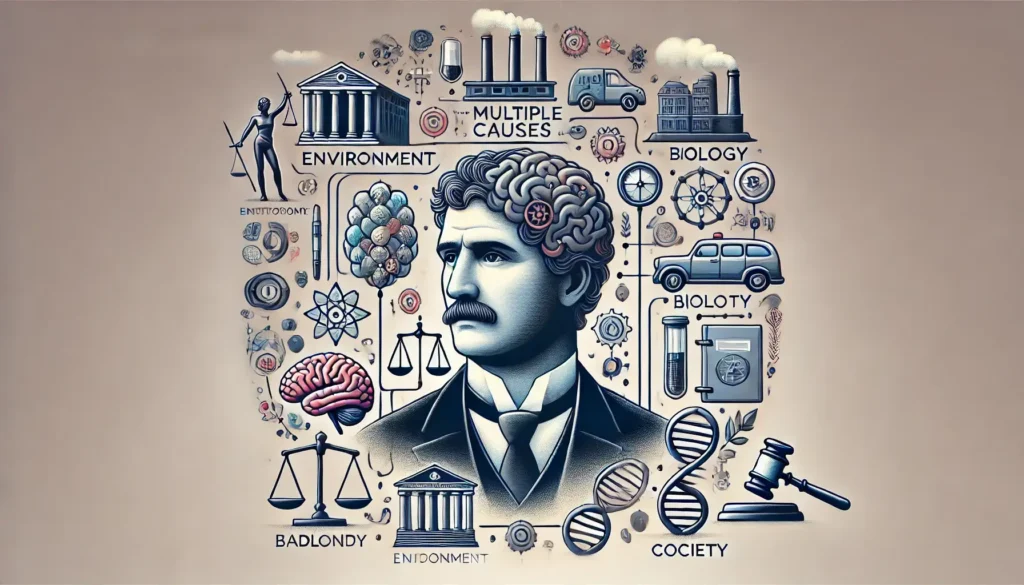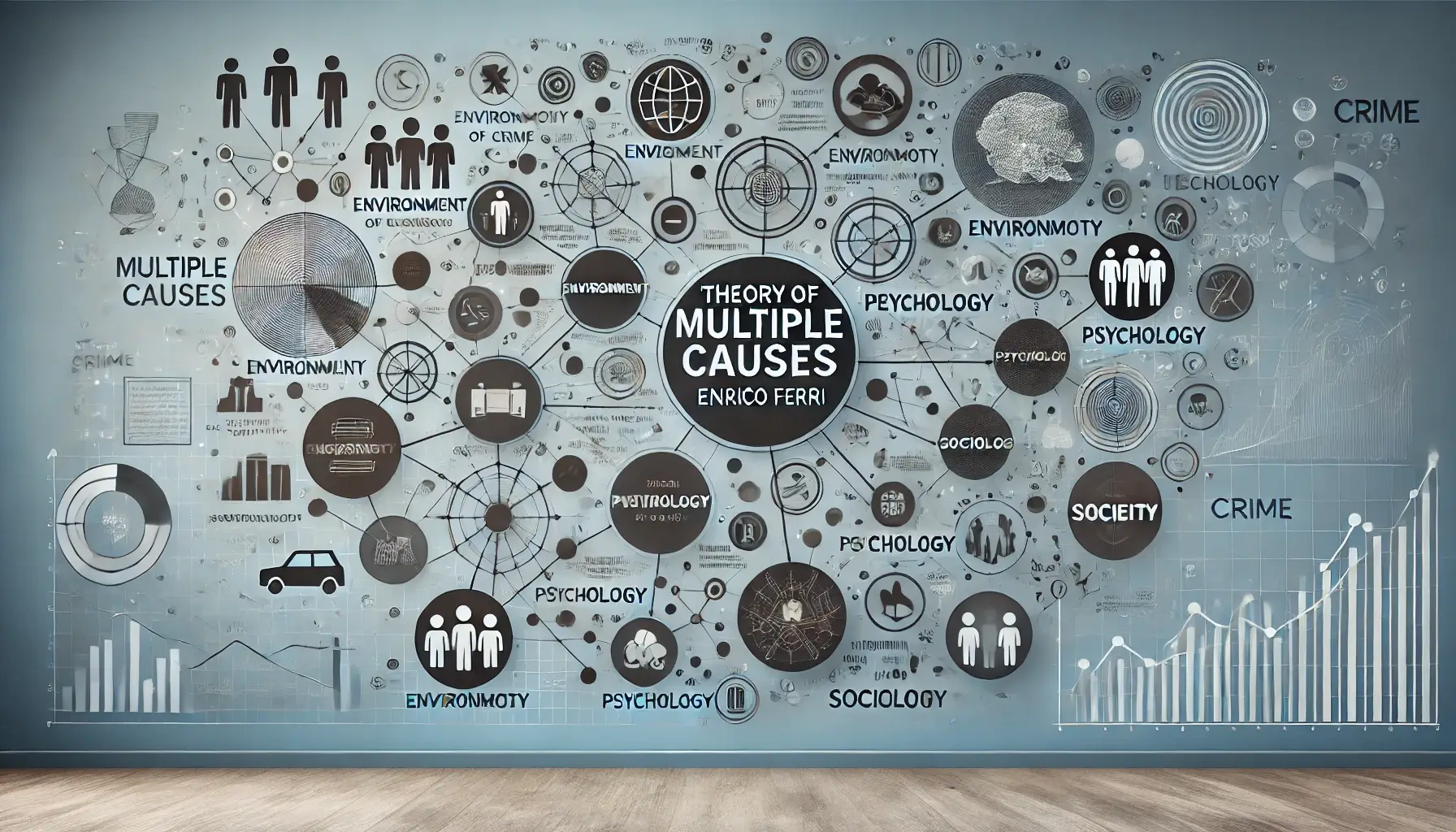Introduction
The field of criminology has evolved over centuries, with multiple theorists contributing to its development. One of the prominent figures in modern criminology is Enrico Ferri, an Italian criminologist, sociologist, and politician. Ferri’s theory of multiple causes represents a significant departure from earlier deterministic approaches, such as Cesare Lombroso’s biological determinism. Ferri emphasized the interplay of various factors—biological, psychological, and social—in shaping criminal behavior. This article explores Ferri’s theory of multiple causes, its underlying principles, applications, and relevance in contemporary criminological studies.
Enrico Ferri: A Brief Biography
Born on February 25, 1856, in San Benedetto Po, Italy, Enrico Ferri was a student of Cesare Lombroso, the founder of the Italian School of Positivist Criminology. While influenced by Lombroso’s work, Ferri expanded upon it, arguing that criminal behavior could not be attributed solely to biological factors. He served as a professor of criminal law and was also a prolific writer, publishing works like Criminal Sociology (1884), which laid the foundation for his theory of multiple causes. Ferri’s career extended beyond academia; he was a socialist politician, advocating for reforms in criminal justice to address societal inequities.
The Foundations of Ferri’s Theory of Multiple Causes
The theory of multiple causes was Ferri’s response to the limitations of single-cause explanations of crime, such as Lombroso’s focus on atavism and physical traits. Ferri proposed that criminal behavior arises from the interaction of three primary factors:
- Anthropological Factors: These include biological and psychological traits such as genetic predispositions, mental health issues, and personality disorders.
- Physical or Environmental Factors: These factors encompass geographical and climatic conditions, such as extreme temperatures, natural disasters, and urbanization.
- Social Factors: These are related to the structure and functioning of society, including economic conditions, education, family dynamics, and cultural influences.
A Holistic Perspective
Ferri’s theory marked a shift towards a holistic approach in criminology, emphasizing that no single factor could adequately explain crime. He believed that understanding the interplay of these elements was essential for developing effective crime prevention strategies.
Key Principles of the Theory of Multiple Causes
Ferri’s theory is grounded in several principles, which highlight the complexity of criminal behavior:
- Interdisciplinary Nature of Criminology Ferri argued that criminology is inherently interdisciplinary, requiring insights from biology, sociology, psychology, and law. His approach integrated these fields to provide a comprehensive understanding of crime.
- Determinism and Free Will While Ferri was a determinist, believing that human behavior is influenced by external and internal factors, he also acknowledged the role of individual agency. He contended that societal interventions could mitigate the deterministic elements of criminal behavior.
- Focus on Prevention Over Punishment Ferri was a strong advocate for preventive measures, asserting that addressing the root causes of crime was more effective than punitive actions. He supported reforms in education, labor laws, and urban planning as part of crime prevention.
- Dynamic Interaction of Causes The theory emphasizes that the causes of crime are not static but dynamic, with various factors interacting and changing over time. For instance, economic hardship might exacerbate psychological stress, leading to criminal acts.
Applications of the Theory
Ferri’s theory has influenced multiple areas of criminology and criminal justice:
- Criminal Profiling The integration of biological, psychological, and social factors has become a cornerstone of modern criminal profiling. Law enforcement agencies analyze these elements to predict criminal behavior and identify suspects.
- Rehabilitation Programs Ferri’s emphasis on social and environmental factors has shaped rehabilitation programs that address the root causes of criminal behavior. For example, vocational training and mental health counseling are designed to reduce recidivism.
- Policy Formulation Policymakers have drawn on Ferri’s insights to develop laws and initiatives aimed at improving social conditions. Examples include housing projects, anti-poverty programs, and public education campaigns.
- Criminological Research Ferri’s interdisciplinary approach has inspired extensive research into the multifaceted nature of crime. Studies examining the interaction between genetics and environment, for instance, reflect the principles of his theory.
Criticisms of Ferri’s Theory
Despite its contributions, Ferri’s theory has faced criticism from various quarters:
- Overemphasis on Determinism Critics argue that Ferri’s deterministic outlook undermines the concept of free will and personal accountability. By focusing on external factors, the theory may neglect the moral responsibility of individuals.
- Complexity in Implementation The holistic nature of the theory, while intellectually appealing, poses challenges in practical application. Identifying and addressing all contributing factors to a crime can be resource-intensive and logistically difficult.
- Neglect of Contemporary Issues Ferri’s work, developed in the late 19th and early 20th centuries, does not account for modern phenomena such as cybercrime, global terrorism, and the impact of technology on criminal behavior.

Relevance in Modern Criminology
Ferri’s theory remains highly relevant, particularly in the context of modern challenges:
- Integration of Technology Advances in technology have enhanced the ability to analyze the multiple causes of crime. Big data analytics, for instance, can identify patterns across biological, social, and environmental domains.
- Globalization and Crime Ferri’s emphasis on social factors is pertinent in understanding crimes linked to globalization, such as human trafficking and transnational organized crime.
- Mental Health Awareness The growing recognition of mental health issues as a factor in criminal behavior aligns with Ferri’s anthropological perspective, underscoring the need for psychological support services in criminal justice systems.
Comparative Analysis with Other Criminological Theories
Ferri’s theory of multiple causes stands out for its comprehensive approach but can be contrasted with other prominent theories:
- Classical School Unlike the Classical School, which emphasizes rational choice and free will, Ferri’s theory focuses on deterministic factors that constrain individual decision-making.
- Biological Theories While Ferri acknowledged the role of biology, his inclusion of social and environmental factors provides a more balanced perspective compared to purely biological theories like those of Lombroso.
- Social Theories Ferri’s inclusion of social factors aligns his work with later sociological theories, such as Robert Merton’s strain theory and Edwin Sutherland’s differential association theory.
Conclusion
Enrico Ferri’s theory of multiple causes represents a pivotal moment in the evolution of criminology. By emphasizing the interplay of anthropological, physical, and social factors, Ferri provided a framework that transcends simplistic explanations of crime. His holistic approach has influenced policy, research, and practice, offering valuable insights into the complex nature of criminal behavior. While not without its limitations, Ferri’s work continues to inspire contemporary criminological thought, reminding us of the importance of addressing the multifaceted causes of crime to create a just and equitable society.

